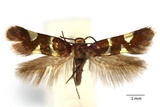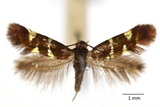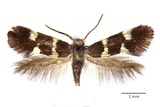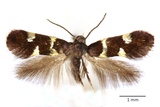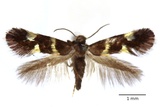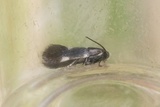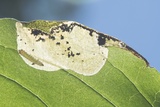Antispila metallella (Denis & Schiffermüller, 1775) Species
Last modified: July 1, 2025, 8:24 p.m.
A rather rare species in Belgium, but probably overlooked in many places.
Details
- Classification
- Family: Heliozelidae > Genus: Antispila > Species: Antispila metallella
- Vernacular names
- Grote kornoeljegaatjesmaker (NL), Four-spot Lift (EN), Hartriegel-Erzglanzfalter (DE)
- Synonyms
- Antispila pfeifferella (Hübner, 1813)
- First mention in Belgium
- De Fré Ch. 1858. Catalogue des Microlépidoptères de la Belgique. — Annales de la Société entomologique belge 2: 45–162. On page 151 (as E.[lachista] Pheifferella. [sic] H.). view page
- Status
-
Native
Distribution
Imago
This species, having a 7–9 mm wingspan, has a bronzy appearance with metallic markings. The pre-apical spot is broadly triangular (while more linear in A. treitschkiella).
Caterpillar
The caterpillar is greenish-white. The head, prothoracic and anal plates are brown.
Mine
The mine initially starts as a short gallery, close to the leaf margin, that suddenly widens into a large blotch. That blotch often overruns the corridor.
See also bladmineerders.be
Bionomics
In preparation for ovipositing, which takes place at the bottom of the leaf close to the leaf edge, the female makes several 'trial punctures', which are later on, often still visible as a curving row of 2–7 brown spots perpendicular to the initial corridor. These trial punctures are typical for this species. If these punctures are absent, one must look at the Cornus species: on Cornus mas it is A. treitschkiella and on Cornus sanguinea it is A. petryi.
The young larva initially constructs a short gallery in a leaf, close to the margin. Afterward, this narrow mine suddenly widens into a large blotch that often overruns the corridor. Eventually, the larva cuts an oval excision of 6–7 mm long and crawls or falls with it to the soil. In this excision, from then on serving as a case, the caterpillar lives on, strolling around freely. Before winter starts, pupation takes place inside this case.
The adults are day-active in full sun.
Flight periods
The adults fly in one generation a year from the end of April till early June.
Observed on
- Host plant (species):
- Cornus sanguinea and Cornus mas
- Host plant (genera):
- Cornus
A. metallella is monophagous on Cornus-species and the main hostplant is Cornus sanguinea and, more rarely, also C. mas.
C. alba and C. sericea are mentioned in the literature as well.
